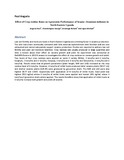| dc.description.abstract | Low soil fertility and moisture levels in North Eastern Uganda are a limiting factor in sesame production. The soils have been continually cultivated with little external replenishment with fertilizer and are now exhausted and cannot adequately support sesame production. Studies are required to address low soil fertility and poor soil moisture retention. Crop residues are usually produced in large quantities and little is known about their effect on sesame growth and yield. An experiment was conducted at NaSARRI-Serere in 2013 B season to investigate the effect of crop residues on sesame growth and yields. Two levels of four crop residues were applied on sesim II variety (Millet; 3 tons/ha and 6 tons/ha, Sorghum; 3 tons/ha and 6 tons/ha, Cowpea; 3 tons/ha and 6 tons/ha and Groundnut; 3 tons/ha and 6 tons/ha). Results show that all growth parameters (plant height, NAR and LAD) increased at the crop residue level of 6 tons/ha. However, 6 tons/ha of millet husks produced taller sesame plants (143.7 cm) and shorter sesame plants (129.87) were produced by groundnut shells. The NAR and LAD were also highest (8.77 and 3.867) respectively with application of 6 tons/ha of millet husks. Seed yield was highest (513 kg/ha) where 6 tons/ha of millet husks were applied and lowest (391 kg/ha) where 3 tons/ha of groundnut shells where applied. The results therefore show that application of millet husks at 6 tons/ha increase both growth and yields of sesame. | en_US |

